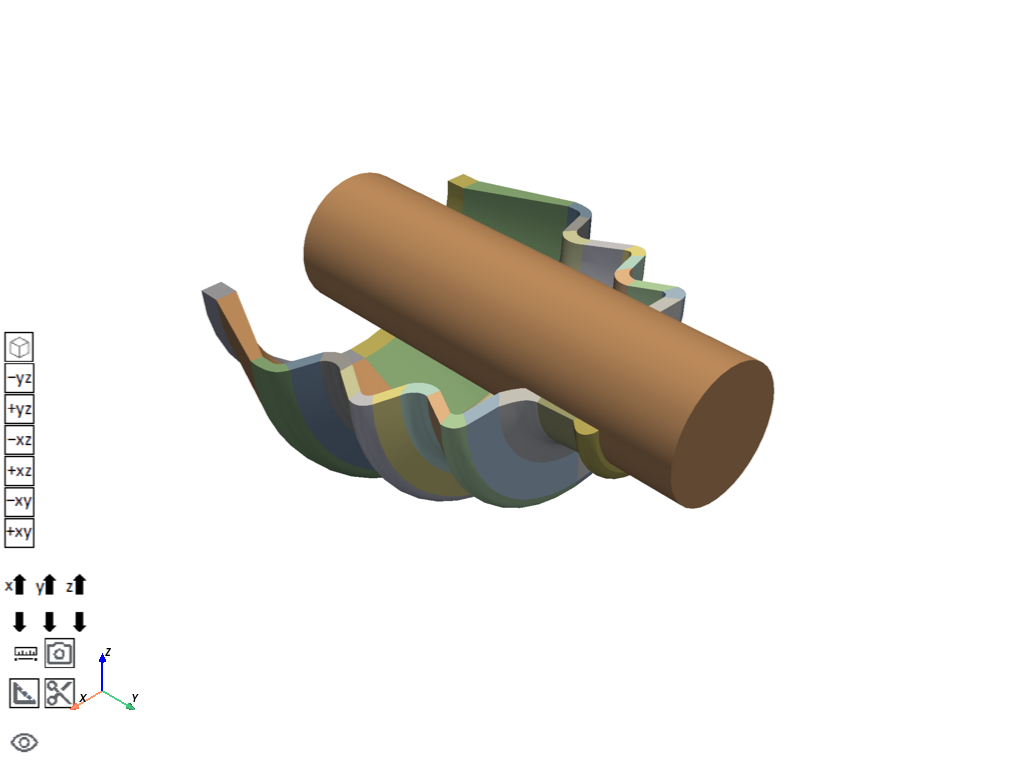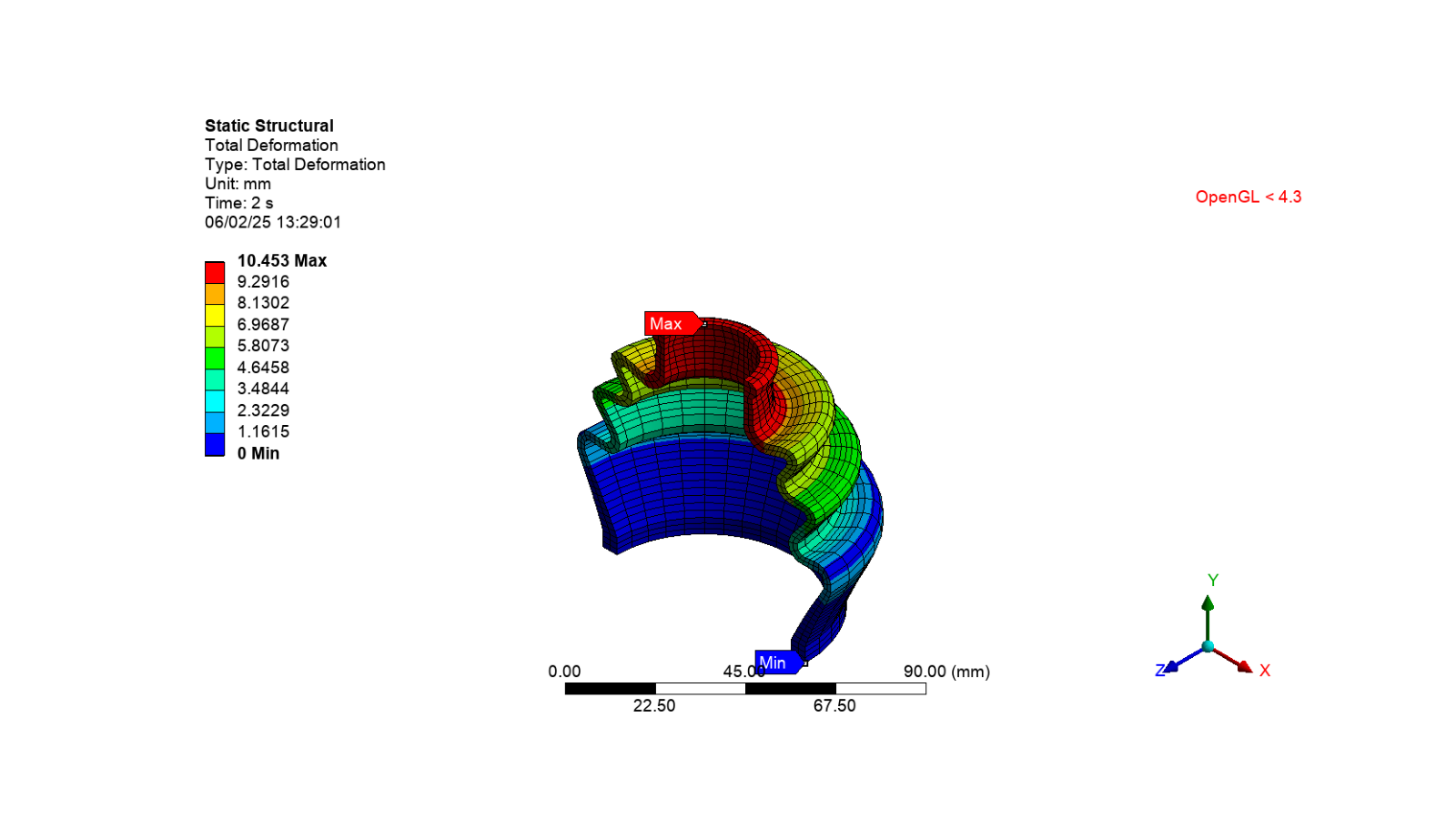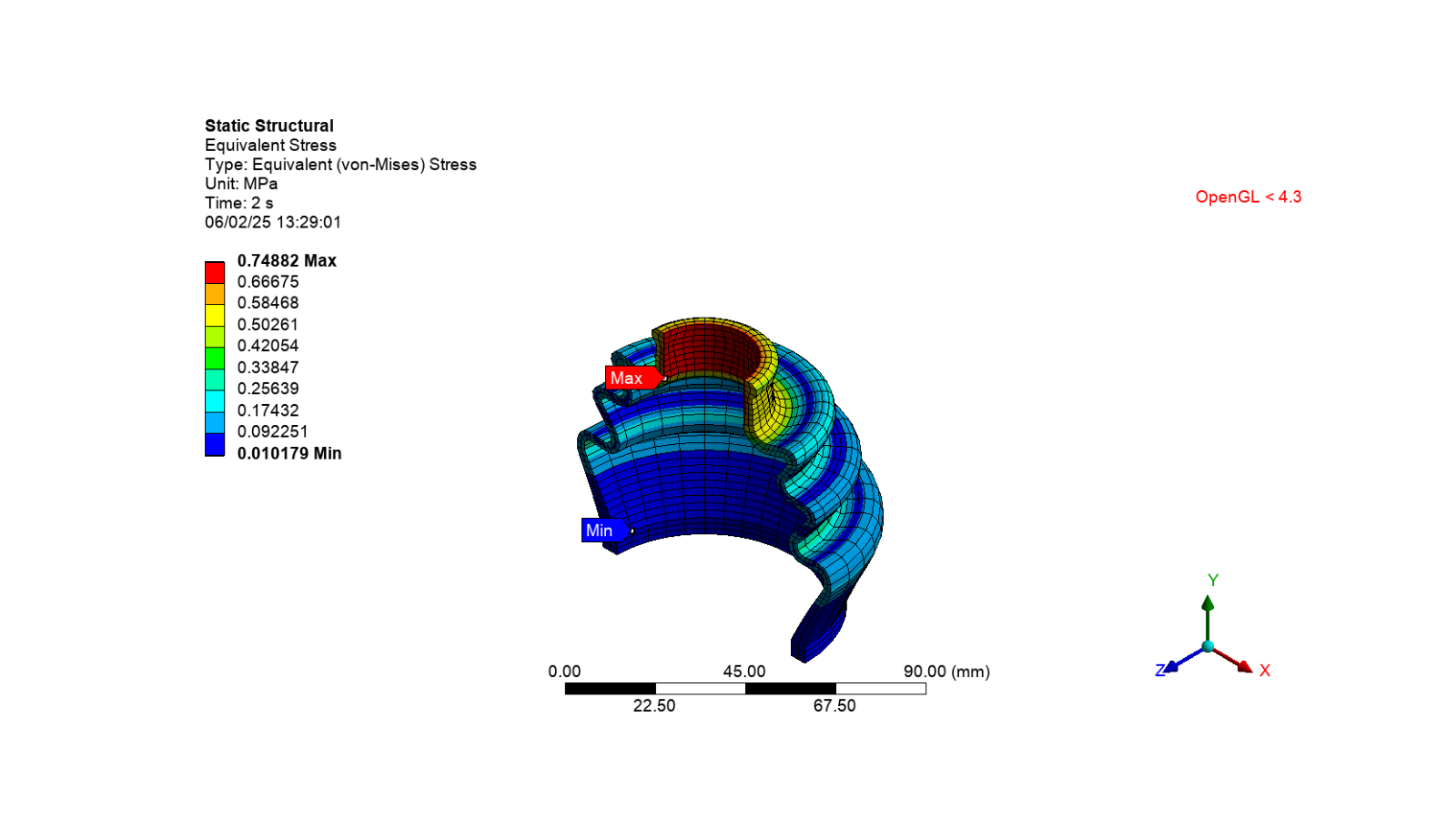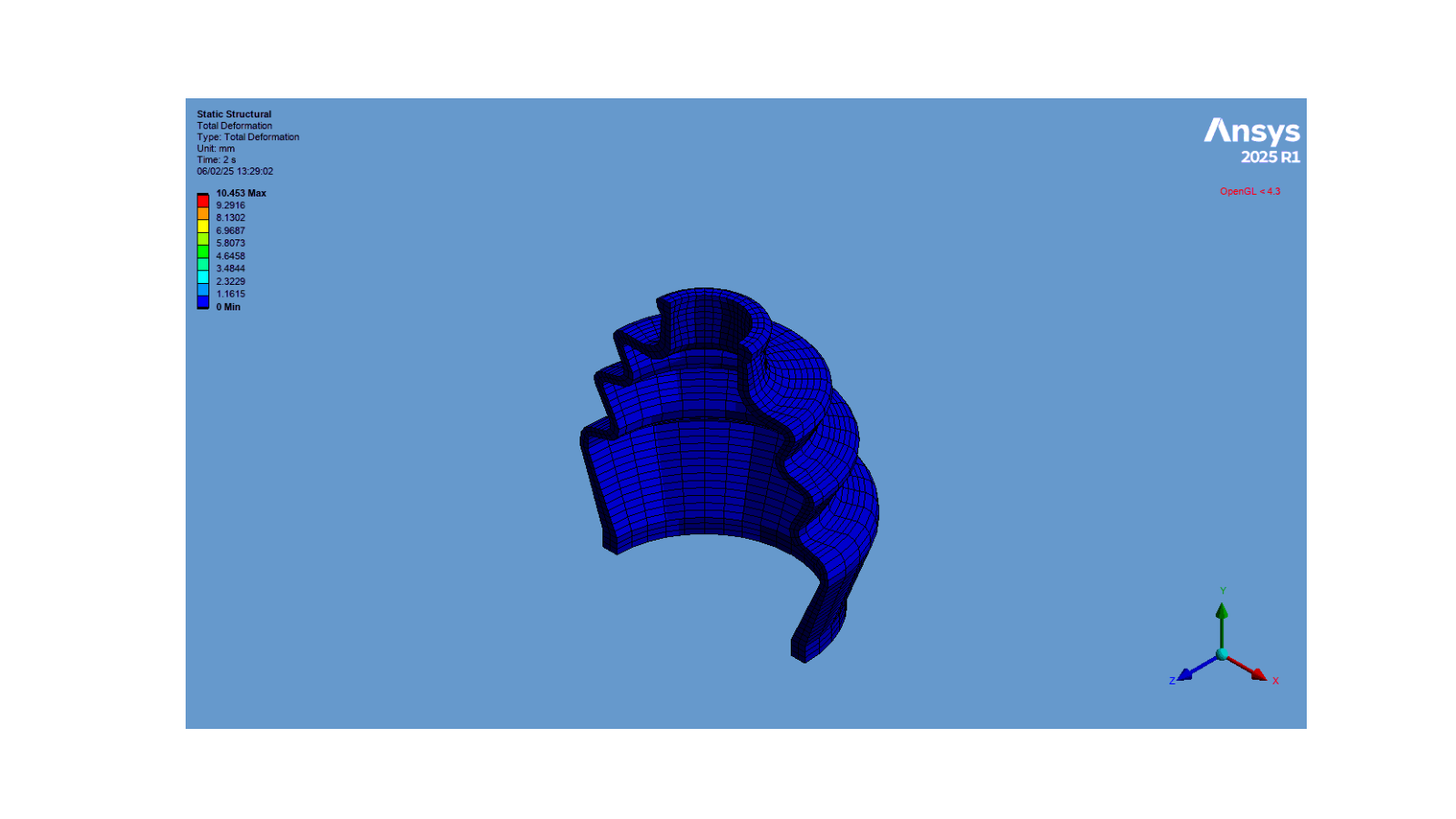Note
Go to the end to download the full example code.
Nonlinear Analysis of a Rubber Boot Seal Model#
This example demonstrates a nonlinear 3D analysis of a rubber boot seal to:
Create a rigid-flexible contact pair between a rigid shaft and a rubber boot part.
Specify ramped effects using the On Gauss Point Detection Method to update contact stiffness at each iteration.
Specify contact pairs at the inner and outer surfaces of the rubber boot.
Specify non-ramped effects using the Nodal-Projected Normal From Contact Detection Method to update contact stiffness at each iteration.
Import the necessary libraries#
from pathlib import Path
from typing import TYPE_CHECKING
from PIL import Image
from ansys.mechanical.core import App
from ansys.mechanical.core.examples import delete_downloads, download_file
from matplotlib import image as mpimg
from matplotlib import pyplot as plt
from matplotlib.animation import FuncAnimation
if TYPE_CHECKING:
import Ansys
Initialize the embedded application#
app = App(globals=globals())
print(app)
Ansys Mechanical [Ansys Mechanical Enterprise]
Product Version:252
Software build date: 06/13/2025 11:25:56
Create functions to set camera and display images#
# Set the path for the output files (images, gifs, mechdat)
output_path = Path.cwd() / "out"
def set_camera_and_display_image(
camera,
graphics,
graphics_image_export_settings,
image_output_path: Path,
image_name: str,
) -> None:
"""Set the camera to fit the model and display the image.
Parameters
----------
camera : Ansys.ACT.Common.Graphics.MechanicalCameraWrapper
The camera object to set the view.
graphics : Ansys.ACT.Common.Graphics.MechanicalGraphicsWrapper
The graphics object to export the image.
graphics_image_export_settings : Ansys.Mechanical.Graphics.GraphicsImageExportSettings
The settings for exporting the image.
image_output_path : Path
The path to save the exported image.
image_name : str
The name of the exported image file.
"""
# Set the camera to fit the mesh
camera.SetFit()
# Export the mesh image with the specified settings
image_path = image_output_path / image_name
graphics.ExportImage(
str(image_path), image_export_format, graphics_image_export_settings
)
# Display the exported mesh image
display_image(image_path)
def display_image(
image_path: str,
pyplot_figsize_coordinates: tuple = (16, 9),
plot_xticks: list = [],
plot_yticks: list = [],
plot_axis: str = "off",
) -> None:
"""Display the image with the specified parameters.
Parameters
----------
image_path : str
The path to the image file to display.
pyplot_figsize_coordinates : tuple
The size of the figure in inches (width, height).
plot_xticks : list
The x-ticks to display on the plot.
plot_yticks : list
The y-ticks to display on the plot.
plot_axis : str
The axis visibility setting ('on' or 'off').
"""
# Set the figure size based on the coordinates specified
plt.figure(figsize=pyplot_figsize_coordinates)
# Read the image from the file into an array
plt.imshow(mpimg.imread(image_path))
# Get or set the current tick locations and labels of the x-axis
plt.xticks(plot_xticks)
# Get or set the current tick locations and labels of the y-axis
plt.yticks(plot_yticks)
# Turn off the axis
plt.axis(plot_axis)
# Display the figure
plt.show()
Configure graphics for image export#
graphics = app.Graphics
camera = graphics.Camera
# Set the camera orientation to the isometric view
camera.SetSpecificViewOrientation(
Ansys.Mechanical.DataModel.Enums.ViewOrientationType.Iso
)
camera.SetFit()
# Set the image export format and settings
image_export_format = GraphicsImageExportFormat.PNG
settings_720p = Ansys.Mechanical.Graphics.GraphicsImageExportSettings()
settings_720p.Resolution = GraphicsResolutionType.EnhancedResolution
settings_720p.Background = GraphicsBackgroundType.White
settings_720p.Width = 1280
settings_720p.Height = 720
settings_720p.CurrentGraphicsDisplay = False
Download the geometry and material files#
geometry_path = download_file(
"example_05_td26_Rubber_Boot_Seal.agdb", "pymechanical", "00_basic"
)
mat_path = download_file("example_05_Boot_Mat.xml", "pymechanical", "00_basic")
Import the geometry and material#
Import the material
model = app.Model
materials = model.Materials
materials.Import(mat_path)
<System.Collections.Generic.List[Material] object at 0x7f853ef53d80>
Import the geometry
# Add a geometry import to the geometry import group for the model
geometry_import = model.GeometryImportGroup.AddGeometryImport()
# Set the geometry import format and preferences
geometry_import_format = (
Ansys.Mechanical.DataModel.Enums.GeometryImportPreference.Format.Automatic
)
geometry_import_preferences = Ansys.ACT.Mechanical.Utilities.GeometryImportPreferences()
geometry_import_preferences.ProcessNamedSelections = True
geometry_import_preferences.ProcessCoordinateSystems = True
# Import the geometry with the specified format and preferences
geometry_import.Import(
geometry_path, geometry_import_format, geometry_import_preferences
)
# Visualize the imported geometry in 3D
app.plot()

[]
Set up the analysis#
# Set the active unit system and angle unit
app.ExtAPI.Application.ActiveUnitSystem = MechanicalUnitSystem.StandardNMM
app.ExtAPI.Application.ActiveAngleUnit = AngleUnitType.Radian
Store all main tree nodes as variables
# Define the geometry for the model
geometry = model.Geometry
# Get the part and solid objects from the geometry
part1 = app.DataModel.GetObjectsByName("Part")[0]
part2 = app.DataModel.GetObjectsByName("Solid")[1]
# Define the coordinate systems
coordinate_systems = model.CoordinateSystems
geometry_coordinate_systems = coordinate_systems.Children[0]
Add a static structural analysis
# Add a static structural analysis to the model
model.AddStaticStructuralAnalysis()
# Get the static structural analysis from the model
static_structural_analysis = model.Analyses[0]
# Get the analysis settings, solution, and solution information
analysis_settings = static_structural_analysis.Children[0]
stat_struct_soln = static_structural_analysis.Solution
soln_info = stat_struct_soln.SolutionInformation
Create a function to get named selections
def get_named_selection(
named_selections, name: str
) -> Ansys.ACT.Automation.Mechanical.NamedSelection:
"""Get a named selection by its name.
Parameters
----------
named_selections : Ansys.ACT.Automation.Mechanical.NamedSelections
The named selections object to search in.
name : str
The name of the named selection to retrieve.
Returns
-------
Ansys.ACT.Automation.Mechanical.NamedSelection
The named selection object.
"""
return [
child
for child in named_selections.GetChildren[
Ansys.ACT.Automation.Mechanical.NamedSelection
](True)
if child.Name == name
][0]
Define named selections and coordinate systems
named_selections = app.ExtAPI.DataModel.Project.Model.NamedSelections
top_face = get_named_selection(named_selections, "Top_Face")
bottom_face = get_named_selection(named_selections, "Bottom_Face")
symm_faces30 = get_named_selection(named_selections, "Symm_Faces30")
faces2 = get_named_selection(named_selections, "Faces2")
cyl_faces2 = get_named_selection(named_selections, "Cyl_Faces2")
rubber_bodies30 = get_named_selection(named_selections, "Rubber_Bodies30")
inner_faces30 = get_named_selection(named_selections, "Inner_Faces30")
outer_faces30 = get_named_selection(named_selections, "Outer_Faces30")
shaft_face = get_named_selection(named_selections, "Shaft_Face")
symm_faces15 = get_named_selection(named_selections, "Symm_Faces15")
# Add a coordinate system and set its origin y-coordinate
lcs1 = coordinate_systems.AddCoordinateSystem()
lcs1.OriginY = Quantity("97[mm]")
Assign material
# Set the material for the rubber boot part
part1.Material = "Boot"
# Set the stiffness behavior for the rubber boot part
part2.StiffnessBehavior = StiffnessBehavior.Rigid
Create a function to add a contact region and set its properties
def add_contact_region_and_props(
body,
target_location,
src_location,
set_src_first: bool = True,
contact_type=ContactType.Frictional,
friction_coefficient=0.2,
behavior=ContactBehavior.Asymmetric,
small_sliding=ContactSmallSlidingType.Off,
detection_method=ContactDetectionPoint.OnGaussPoint,
update_stiffness=UpdateContactStiffness.EachIteration,
):
"""Add a contact region and set its properties.
Parameters
----------
body : Ansys.ACT.Automation.Mechanical.Body
The body to which the contact region is added.
target_location : Ansys.ACT.Automation.Mechanical.NamedSelection
The target location for the contact region.
src_location : Ansys.ACT.Automation.Mechanical.NamedSelection
The source location for the contact region.
set_src_first : bool
Whether to set the source location first.
contact_type : ContactType
The type of contact (default is Frictional).
friction_coefficient : float
The friction coefficient for the contact region (default is 0.2).
behavior : ContactBehavior
The behavior of the contact region (default is Asymmetric).
small_sliding : ContactSmallSlidingType
The small sliding type for the contact region (default is Off).
detection_method : ContactDetectionPoint
The detection method for the contact region (default is OnGaussPoint).
update_stiffness : UpdateContactStiffness
The update stiffness method for the contact region (default is EachIteration).
Returns
-------
Ansys.ACT.Automation.Mechanical.ContactRegion
The created contact region.
"""
# Add a contact region to the connection or child connection
contact_region = body.AddContactRegion()
# Set the source and target locations for the contact region
if set_src_first:
contact_region.SourceLocation = src_location
contact_region.TargetLocation = target_location
else:
contact_region.TargetLocation = target_location
contact_region.SourceLocation = src_location
# Set the contact type, friction coefficient, behavior, small sliding,
# detection method, and update stiffness for the contact region
contact_region.ContactType = contact_type
contact_region.FrictionCoefficient = friction_coefficient
contact_region.Behavior = behavior
contact_region.SmallSliding = small_sliding
contact_region.DetectionMethod = detection_method
contact_region.UpdateStiffness = update_stiffness
return contact_region
Add contact regions
# Add a contact region to the connections
connections = model.Connections
contact_region1 = add_contact_region_and_props(
connections,
target_location=shaft_face,
src_location=inner_faces30,
set_src_first=False,
)
# Set interface treatment and target properties
contact_region1.InterfaceTreatment = ContactInitialEffect.AddOffsetRampedEffects
contact_region1.TargetGeometryCorrection = TargetCorrection.Smoothing
contact_region1.TargetOrientation = TargetOrientation.Cylinder
contact_region1.TargetStartingPoint = geometry_coordinate_systems
contact_region1.TargetEndingPoint = lcs1
# Add a contact region to the child connections
conts = connections.Children[0]
contact_region2 = add_contact_region_and_props(
conts,
target_location=inner_faces30,
src_location=inner_faces30,
detection_method=ContactDetectionPoint.NodalProjectedNormalFromContact,
)
# Set the stiffness value type and factor
contact_region2.NormalStiffnessValueType = ElementControlsNormalStiffnessType.Factor
contact_region2.NormalStiffnessFactor = 1
# Add a contact region to the child connections
contact_region3 = add_contact_region_and_props(
conts,
target_location=outer_faces30,
src_location=outer_faces30,
detection_method=ContactDetectionPoint.NodalProjectedNormalFromContact,
)
# Set the stiffness value type and factor
contact_region3.NormalStiffnessValueType = ElementControlsNormalStiffnessType.Factor
contact_region3.NormalStiffnessFactor = 1
Add face meshing and sizing#
# Define the mesh for the model
mesh = model.Mesh
# Add face meshing to the mesh
face_mesh = mesh.AddFaceMeshing()
# Set the location of the face mesh to the shaft face
# and set the internal number of divisions to 1
face_mesh.Location = shaft_face
face_mesh.InternalNumberOfDivisions = 1
# Add sizing to the mesh
mesh_size = mesh.AddSizing()
# Set the location of the mesh size to the symmetry faces
# and set the element size to 2 mm
mesh_size.Location = symm_faces15
mesh_size.ElementSize = Quantity("2 [mm]")
mesh.ElementOrder = ElementOrder.Linear
mesh.Resolution = 2
# Generate the mesh and display the image
mesh.GenerateMesh()
set_camera_and_display_image(camera, graphics, settings_720p, output_path, "mesh.png")

Add remote points#
def add_remote_point(
model,
location,
behavior=LoadBehavior.Rigid,
):
"""Add a remote point to the model.
Parameters
----------
model : Ansys.ACT.Automation.Mechanical.Model
The model to which the remote point is added.
location : Ansys.ACT.Automation.Mechanical.NamedSelection
The location of the remote point.
behavior : LoadBehavior
The behavior of the remote point (default is Rigid).
Returns
-------
Ansys.ACT.Automation.Mechanical.RemotePoint
The created remote point.
"""
remote_point = model.AddRemotePoint()
remote_point.Location = location
remote_point.Behavior = behavior
return remote_point
remote_point01 = add_remote_point(model, bottom_face)
remote_point02 = add_remote_point(model, top_face)
Configure the analysis settings#
Define a function to set the analysis settings
def set_analysis_settings(
analysis_settings,
current_step_number: int,
initial_substeps: int,
minimum_substeps: int,
store_results_at_value: int,
automatic_time_stepping: bool = AutomaticTimeStepping.On,
define_by: TimeStepDefineByType = TimeStepDefineByType.Substeps,
maximum_substeps: int = 1000,
store_results_at: TimePointsOptions = TimePointsOptions.EquallySpacedPoints,
):
analysis_settings.CurrentStepNumber = current_step_number
analysis_settings.AutomaticTimeStepping = automatic_time_stepping
analysis_settings.DefineBy = define_by
analysis_settings.InitialSubsteps = initial_substeps
analysis_settings.MinimumSubsteps = minimum_substeps
analysis_settings.MaximumSubsteps = maximum_substeps
analysis_settings.StoreResultsAt = store_results_at
analysis_settings.StoreResulsAtValue = store_results_at_value
Configure the analysis settings
analysis_settings.Activate()
analysis_settings.LargeDeflection = True
analysis_settings.Stabilization = StabilizationType.Off
analysis_settings.NumberOfSteps = 2
set_analysis_settings(
analysis_settings,
current_step_number=1,
initial_substeps=5,
minimum_substeps=5,
store_results_at_value=5,
)
set_analysis_settings(
analysis_settings,
current_step_number=2,
initial_substeps=10,
minimum_substeps=10,
store_results_at_value=10,
)
set_analysis_settings(
analysis_settings,
current_step_number=3,
initial_substeps=30,
minimum_substeps=30,
store_results_at_value=20,
)
soln_info.NewtonRaphsonResiduals = 4
Set load and boundary conditions#
remote_displacement = static_structural_analysis.AddRemoteDisplacement()
remote_displacement.Location = remote_point01
Define a function to convert a list of values to quantities
def convert_to_quantity(quantity_list: tuple) -> list:
"""Convert a list of values to quantities.
Parameters
----------
quantity_list : tuple
A tuple containing a list of values and the unit.
Returns
-------
list
A list of quantities with the specified unit.
"""
values, unit = quantity_list
return [Quantity(f"{value} [{unit}]") for value in values]
Set the input values for all remote displacement components
input_values = convert_to_quantity(([0, 1, 2, 3], "s"))
Set the X component input and output values
x_component = remote_displacement.XComponent
x_component.Inputs[0].DiscreteValues = input_values
x_component.Output.DiscreteValues = convert_to_quantity(([0, 0, 0, 0], "mm"))
Set the Y component input and output values
y_component = remote_displacement.YComponent
y_component.Inputs[0].DiscreteValues = input_values
y_component.Output.DiscreteValues = convert_to_quantity(([0, 0, -10, -10], "mm"))
Set the Z component input and output values
z_component = remote_displacement.ZComponent
z_component.Inputs[0].DiscreteValues = input_values
z_component.Output.DiscreteValues = convert_to_quantity(([0, 0, 0, 0], "mm"))
Set the rotation X component input and output values
rotation_x = remote_displacement.RotationX
rotation_x.Inputs[0].DiscreteValues = input_values
rotation_x.Output.DiscreteValues = convert_to_quantity(([0, 0, 0, 0], "rad"))
Set the rotation X component input and output values
rotation_y = remote_displacement.RotationY
rotation_y.Inputs[0].DiscreteValues = input_values
rotation_y.Output.DiscreteValues = convert_to_quantity(([0, 0, 0, 0], "rad"))
Set the rotation Z component input and output values
rotation_z = remote_displacement.RotationZ
rotation_z.Inputs[0].DiscreteValues = input_values
rotation_z.Output.DiscreteValues = convert_to_quantity(([0, 0, 0, 0.55], "rad"))
Add frictionless support to the static structural analysis
def add_frictionless_support(
static_structural_analysis,
location,
name: str,
):
"""Add frictionless support to the static structural analysis.
Parameters
----------
static_structural_analysis : Ansys.ACT.Automation.Mechanical.StaticStructuralAnalysis
The static structural analysis object.
location : Ansys.ACT.Automation.Mechanical.NamedSelection
The location of the frictionless support.
name : str
The name of the frictionless support.
Returns
-------
Ansys.ACT.Automation.Mechanical.FrictionlessSupport
The created frictionless support.
"""
frictionless_support = static_structural_analysis.AddFrictionlessSupport()
frictionless_support.Location = location
frictionless_support.Name = name
return frictionless_support
add_frictionless_support(static_structural_analysis, symm_faces30, "Symmetry_BC")
add_frictionless_support(static_structural_analysis, faces2, "Boot_Bottom_BC")
add_frictionless_support(static_structural_analysis, cyl_faces2, "Boot_Radial_BC")
<Ansys.ACT.Automation.Mechanical.BoundaryConditions.FrictionlessSupport object at 0x7f853ef1f380>
Add results#
# Add total deformation results to the solution
total_deformation = static_structural_analysis.Solution.AddTotalDeformation()
total_deformation.Location = rubber_bodies30
# Add equivalent stress results to the solution
equivalent_stress = static_structural_analysis.Solution.AddEquivalentStress()
equivalent_stress.Location = rubber_bodies30
Solve the static structural analysis#
static_structural_analysis.Solution.Solve(True)
Postprocessing#
# Activate the total deformation result and display the image
app.Tree.Activate([total_deformation])
set_camera_and_display_image(
camera, graphics, settings_720p, output_path, "total_deformation.png"
)

Equivalent stress
# Activate the equivalent stress result and display the image
app.Tree.Activate([equivalent_stress])
set_camera_and_display_image(
camera, graphics, settings_720p, output_path, "equivalent_stress.png"
)

Create a function to set the animation for the GIF
def update_animation(frame: int) -> list[mpimg.AxesImage]:
"""Update the animation frame for the GIF.
Parameters
----------
frame : int
The frame number to update the animation.
Returns
-------
list[mpimg.AxesImage]
A list containing the updated image for the animation.
"""
# Seeks to the given frame in this sequence file
gif.seek(frame)
# Set the image array to the current frame of the GIF
image.set_data(gif.convert("RGBA"))
# Return the updated image
return [image]
Show the total deformation animation
# Set the animation export format and settings
animation_export_format = (
Ansys.Mechanical.DataModel.Enums.GraphicsAnimationExportFormat.GIF
)
settings_720p = Ansys.Mechanical.Graphics.AnimationExportSettings()
settings_720p.Width = 1280
settings_720p.Height = 720
# Export the total deformation animation as a GIF
total_deformation_gif = output_path / "total_deformation.gif"
total_deformation.ExportAnimation(
str(total_deformation_gif), animation_export_format, settings_720p
)
# Open the GIF file and create an animation
gif = Image.open(total_deformation_gif)
# Set the subplots for the animation and turn off the axis
figure, axes = plt.subplots(figsize=(16, 9))
axes.axis("off")
# Change the color of the image
image = axes.imshow(gif.convert("RGBA"))
# Create the animation using the figure, update_animation function, and the GIF frames
# Set the interval between frames to 200 milliseconds and repeat the animation
FuncAnimation(
figure,
update_animation,
frames=range(gif.n_frames),
interval=200,
repeat=True,
blit=True,
)
# Show the animation
plt.show()

Clean up the project#
# Save the mechdat file
mechdat_file = output_path / "non_linear_rubber_boot_seal.mechdat"
app.save(str(mechdat_file))
# Close the app
app.close()
# Delete the example files
delete_downloads()
True
Total running time of the script: (1 minutes 52.183 seconds)

